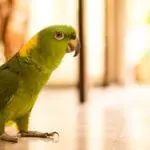Having under a situation where your pet bird will need CPR is something that should never be wished upon any bird keeper. But even though this is something that no one wants, it is still important to gain the appropriate knowledge so that you will be able to support your bird just in case an emergency occurs.
Consider this. If something happens and your pet bird suddenly stops breathing, CPR, or Cardio Pulmonary Resuscitation can be done on your feathered friend. If you think about, you will not have the time to read through any instruction manual that will immediately help you ease the pain of your pet.
Would Birds Really Need CPR?
It might come as a surprise at first, but birds and other animals need to be administered CPR, too. Animals, including birds, have a heartbeat and breathe, which means this can be stopped by some accidents or health problems, just like humans.
According to some wildlife veterinarians, about 5 percent of bird visits in the veterinarian require CPR as a treatment. Some things that can trigger cardiac arrest are hemorrhages, poisoning, and severe infection. Sometimes, it can be due to a very simple concern: a bird mistakenly inhaling a seed that blocks their airway.
In dealing with a bird, just make sure to remember three things: airway, breathing, and pulse.
The Steps In Administering CPR For Birds
1. Remain calm.
- This may sound simple, but this is the most important thing.
- When your bird is having breathing problems, you should make sure that you are clear-headed during the entire process so that you can act much quicker.
2. Observe the condition of your bird.
- Look for visible signs of breathing. You can do this by observing the rise and fall of the chest and sternum of the bird. Take note that there is a chance that you might not get to detect the exhalations of your bird.
- Listen to the heartbeat by putting your ear towards your bird’s chest. Try locating your bird’s heart by looking at this diagram below.
- The heart is placed quite lower and towards the central part of the chest. Both sides of it must be listened to so that you will be able to find a heartbeat.
- A bird that is need of a CPR treatment will be unconscious, no heartbeat, and unconscious.
- Sometimes, it might seem like a bird is no longer breathing, but is still alive because of their strong heartbeat. For cases like this, the only thing you must do is to administer the breaths to your bird. There will be no need to do some compressions.
- While administering breaths, you should keep trying to find a heartbeat because the heart might stop beating while you are breathing air for your bird.
- Check the airway of your bird so that you can ensure that there will be no obstruction and clear a path for air just in case there is a blockage.
- Try finding the opening to the bird’s trachea. If the tongue is blocking it, you might have to reposition that.

3. If there is a heartbeat, you should try breathing for your bird.
- Hold your bird on its back while still trying to support the bird’s head.
- If your pet is a small bird, you should place your mouth towards the beak of your bird and over the nares of your pet. To find the nares, you should check for the fleshy area where the head of the bird meets its beak.
- If you have a large bird, you should close your mouth around the bird’s beak, and you should cover the holes on the nares, or the nostrils, using your finger. This will make sure that the air you are breathing in will not get diverted out of your bird’s body.
- The amount of air and the force you exert to provide for your pet bird must always be the appropriate volume for the size of your bird. There are no exact instructions for this, so you, as an owner, should trust your gut feeling.
- Begin by taking a deep breath and release air through 5 short puffs in quick succession. Pause to check if the bird is breathing on its own. If there is still no breathing action, deliver two more breaths, and pause to reevaluate your bird’s status.
- Continue the CPR by administering 2 breaths at a time until the bird is strong enough to breathe on its own.
4. If there is no heartbeat and no breathing, begin the CPR process.
- CPR depends on the issuance of chest compressions that are delivered over your bird’s heart at its sternum. If you have a small bird, only do this using one finger. If you have a large bird, you can go with three.
- The pressure must change depending on the specific size of your bird. Make sure that it is not too weak or too strong. Remember that the compressions must mimic the movement of a heart – it should be rhythmic and brisk.
- You should keep your heartbeat in mind while you are applying some pressure. To help you, you should see the movement of your sternum while you are doing it effectively.
- The pattern of giving CPR must be 5 breaths followed by 10 compressions, 2 breaths followed by 10 compressions, 2 breaths followed by 10 compressions, and so on.
- You should cease your actions per reaching a single minute in order to re-evaluate the performance of both breathing, as well as heartbeat.
- Keep your CPR and rescue breathing activities until you have resuscitated your bird or until you have safely arrived at your trusted avian veterinarian.
Some Additional Tips
- Watch your bird’s breast to see if it rises according to the breaths that you puff in. The location where you can see them clearest is the part of the body where your breast muscles meet your abdomen.
- If you can see that the bird’s breast is not rising as high as it should, check again for blockage.
- Birds are usually seen with a very quick heartbeat so that you will try and simulate that with gentle but rhythmic finger pressure.
- You should press very quickly, at about 40 to 60 compressions in a minute, with checking at least once every minute.
- It can help to count out loud as you go so that you can keep track of counting and maintain your rhythm.
- It also helps to enroll in a CPR class, regardless if this one is for humans. The principles are the same, and it can help you with helping your pet if it encounters an emergency.
- You can also practice Avian CPR on a stuffed toy bird, just the same as how humans practice with a doll.
CPR must not be practiced on breathing, live, and conscious birds. This attempt can be very harmful to healthy birds, as well as for you because you can get your tongue and lips bitten by your pet bird.


